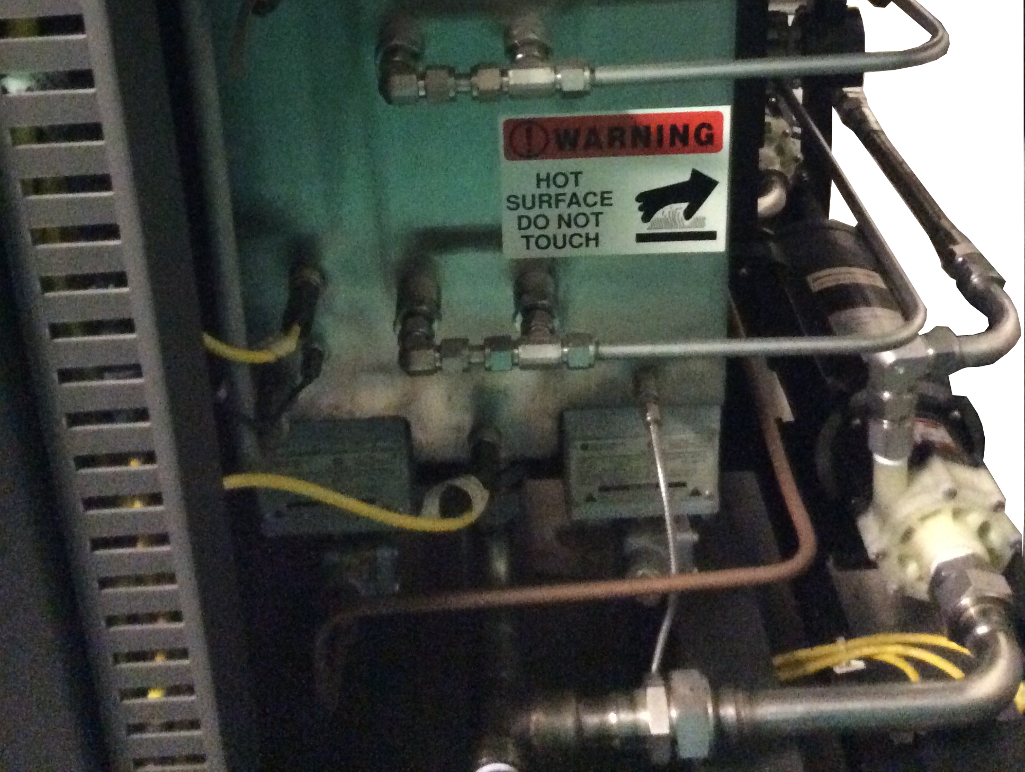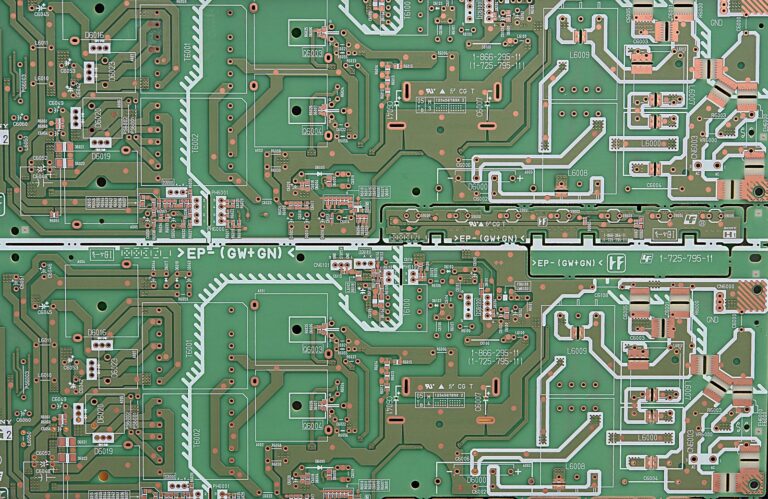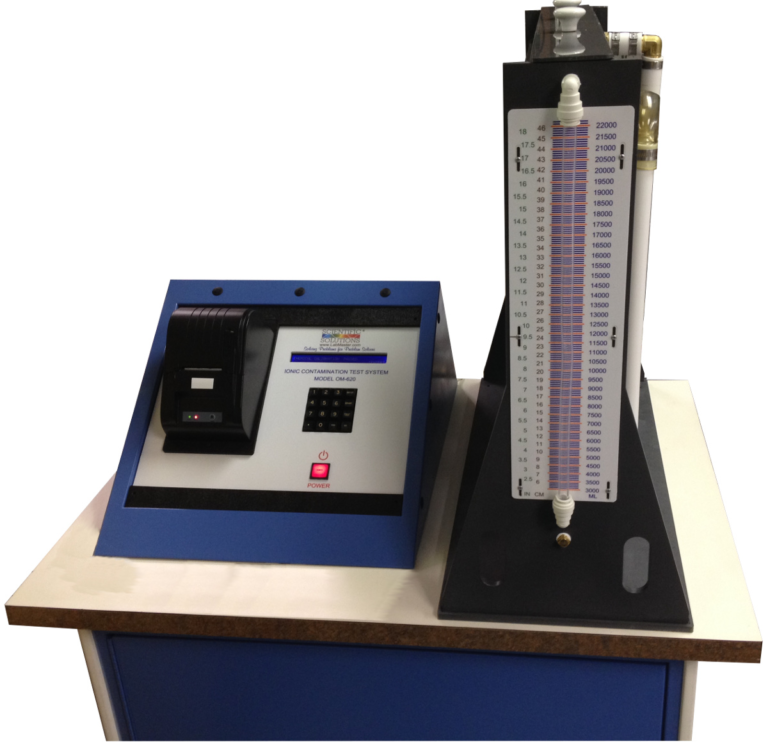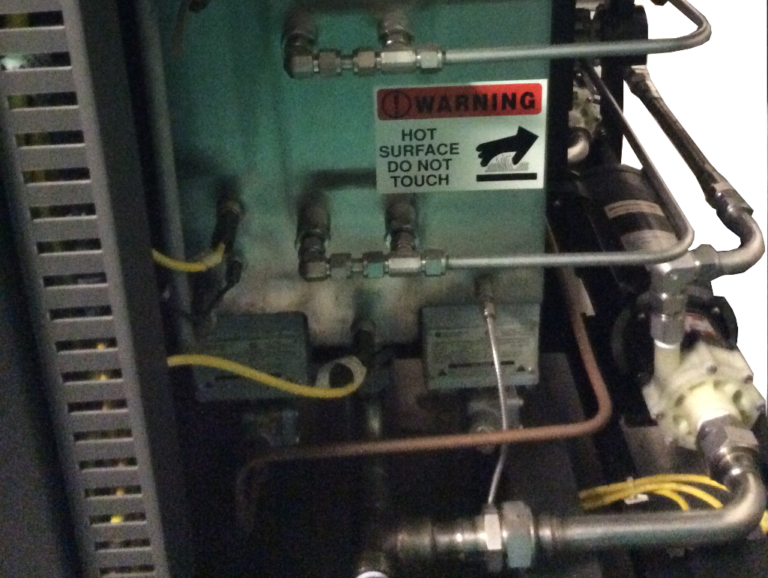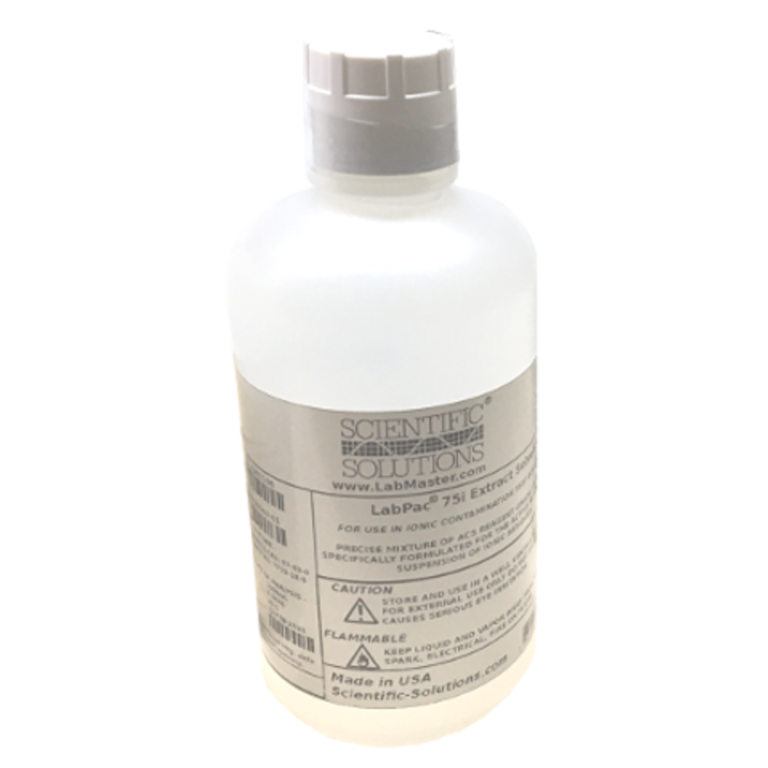A laboratory study – Heat vs Non-Heat in Ionic Testing.
In this paper, we discuss the difference between heating or not heating the Test Solvent when performing a test. The OM600R does not have the ability to heat. The OM600SMD does
have heating as an option which can be selected by the operator if desired.
10.1 Is Heating Required by IPC-TM-650 2.3.25 Specification ?
Reference: IPC-TM-650 2.3.25 Resistivity of Solvent Extract (ROSE) Test Method.
The above referenced IPC document mentions the use of heating of the Test Solvent in
sections 5.2, 6.2 and 7.1.
We cite these statements to provide answers to the following questions:
(1). Does the standard require heating of the Test Solvent?
NO
(2). Does a non-heated ionic contamination measurement system adhere to the standard?
YES
(3). Do you have to heat the Test Solvent to the same temperature for testing and calibration?
NO, as long as you have Temperature Compensation
10.2 Discussion of IPC-TM-650 2.3.25 Section 5.2 Dynamic and 6.2 Static
IPC-TM-650 2.3.35 Section 5.2 Dynamic Test Equipment
“The equipment may have the capability of heating the 2-propanol/DI water mixture to
accelerate extraction of ionic soils from poorly accessible places such as under
surface mounted components.”
IPC-TM-650 2.3.35 Section 6.2 Static Test Equipment
“The equipment may also have the capability of heating the 2-propanol/DI water
mixture to accelerate and improve the efficiency of extraction of ionic material from
poorly accessible regions, such as under surface mounted components.”
The above statements indicate that heating the Test Solvent is optional for both Static and
Dynamic systems. Heating “accelerates” the extraction of ionic contamination which means
that a heated solution can remove ionic contamination faster than a cooler solution. Increased
temperature results in a faster extraction time. So, for a set “short” time, a heated solution can remove more contamination than a cooler solution. For a “longer” time that will not be the
case, as discussed below. However since a heated solution extracts contaminants faster, it
improves the “efficiency” of the machine since it takes less time to extract the contamination,
and less time is more efficient. However, you also need to account for the time it takes to heat
up the solvent.
10.3 Discussion of IPC-TM-650 2.3.25 Section 7.1 Temperature
IPC-TM-650 2.3.35 Section 7.1 Temperature
“Higher solution temperatures will result in higher levels of extracted ionic material.
Most machines have calculation algorithms which incorporate the solution temperature.
Refer to the machine documentation to understand how temperature affects the ionic
contamination reading.
For process control testing, temperature should be set at a constant value for periodic
measurements. All calibrations of the equipment should be made at the same solution
temperature used to run the test.”
The above statements from section 7.1 of the IPC document can be summarized as follows:
1) Higher solution temperatures will result in higher levels of extracted ionic material.
2) Most machines have calculation algorithms which incorporate the solution temperature.
3) For process control testing, temperature should be set at a constant value for periodic
measurements
4) All calibrations of the equipment should be made at the same solution temperature
used to run the test.
In the next sections, we examine each of the above statements:
10.31 Higher Temperatures Result in Higher Extractions (true or false) ?
1). Higher solution temperatures will result in higher levels of extracted ionic material.
The above statement from the IPC document section 7.1 is a little vague in that it does not
include a reference to time, which is a very important omission. If a test is run too quickly,
then independent of the solution temperature, the total amount of contamination that could
be extracted from a sample is not obtained.
For example, if you run a test for 30 seconds, you will get much different results than if you
run a test for 5 minutes. The time a test is run must be sufficient to assure that as much contamination as possible is extracted.
This part of the 7.1 statement should really say “Higher solution temperatures will result in
higher levels of extracted ionic material over a given limited time.” We know from sections
5.2 and 6.2 that heated test solvent will help extract contamination quicker. However, over
a sufficient length of time, both heated and non-heated solvent should extract the same
amount of contamination.
So basically, what the IPC specification says is that heating the Test Solvent, which is an
option not a requirement, will allow the test to be run quicker. How much quicker? If you
have a system with optional heat, then run a test with heat and run a test without heat and
see if the heated test is substantially quicker than the non-heated test. Also, compare the
results. In extensive testing with heated and non-heated Test Solvent, we have found no
appreciable difference in either test time or contamination results
10.32 Machines have Temperature Compensation.
2). Most machines have calculation algorithms which incorporate the solution
temperature.
The above statement is from the IPC document section 7.1. In general, temperature
compensation is a method used to adjust a system’s measurement to compensate for
effects caused by changes in temperature. The idea of temperature compensation is to
remove the effects of temperature on the final results. That is, make it so any difference in
temperature has no effect on the measurements.
How does this work? The system has a specific temperature defined as the “standard”
temperature. At any temperature the system makes a resistivity measurement, it mathematically changes the resistivity measurement to a value it would be if that
measurement had actually been made at the “standard” temperature.
For example, lets say the system has a “standard” temperature of 20oC. Now three resistivity
measurements are taken; one at 15oC, another at 20oC and a third at 38oC. The “raw”
resistivity value of each measurement is different. However, the system adjusts each “raw”
measurement to a “compensated” measurement. The compensation value of each
measurement is the same. So it is as if each measurement was actually made at 20oC.
How does it do this? The Test Solvent temperature is automatically measured at the same
time the resistivity probe makes a “raw” resistivity measurement. The microprocessor in the
system has stored probe calibration data and uses this data, along with the temperature and
the “raw” resistivity measurement to mathematically change the “raw” value into a
“compensated” value. It is this “compensated” value which is used to calculate the total
contamination.
So with temperature compensation, even though measurements are made at different
temperatures, the effect of the different temperatures on the measurements is eliminated and it is as if the measurements were actually taken at the same temperature. Temperature compensation eliminates the need to precisely adjust the temperature of your Test Solvent for
each measurement, but instead makes any temperature equivalent to another. You could say
that temperature compensation makes all temperatures the same.
10.33 Should Testing be always done at the same Temperature ?
3). For process control testing, temperature should be set at a constant value for
periodic measurements
The above statement from the IPC document section 7.1 does not take temperature
compensation into account. As previously discussed, temperature compensation makes
your measurement results independent of temperature. If you did not have temperature
compensation (not all machines have it), then yes it would be very important that each test
be run at the same temperature for process control testing. However, with temperature
compensation, the system is accounting for any differences in temperature and adjusting
all measurements to be equivalent as if taken at the same temperature. So temperature
compensation assures you that all measurements are essentially made at the same
temperature, i.e. the “standard” temperature of compensation used by the system.
10.34 Should Calibration be done at the same Temperature as Testing ?
4). Calibrations should be done at the same solution temperature used to run the test
The above statement from the IPC document section 7.1 does not take temperature
compensation into account. System calibration is really the same process as an actual
test. But instead of using a circuit board with unknown contamination, the calibration
routine uses a “Standardizing Solution” of known contamination. A calibration test is run,
and if all is working correctly the system should report a contamination value with a
predefined range correlating to the Standardizing Solution.
For a normal test you clean the Test Solvent, fill the Test Cell with a volume of cleaned Test
Solvent sufficient to immerse the board, start the test and place the board in the Test Cell.
The routine is likewise for calibration. For calibration you clean the Test Solvent, fill the
Test Cell with a specific volume of cleaned Test Solvent, start the test and place a specific
amount of Standardizing Solution into the Test Cell.
Once the board or Standardizing solution is placed in the Test Cell the actual routine of
running the test or calibration cycle, making the resistivity measurements and calculating
the contamination is exactly the same. If the system does not have temperature
compensation (not all systems have it), then it would be very important that the calibration
be run at the same temperature as an actual test. However, a system with temperature
compensation will adjust the calibration and test results based upon the temperature of
each procedure. The Temperature Compensation is being done in each instance.
10.4
10.4 Using Auto-Termination Instead of Heating
How much time does it take to extract contamination during a test? Since heating makes the
extraction go faster, do I need to heat the Test Solvent in order to extract all the
contamination?
When you run a test you have two choices to determine when the test ends. One choice is to
end a test after a fixed amount of time, and the other choice is to end a test based upon the
contamination readings, referred to as auto terminate
Fixed-Time:
In this first case, the test is run for a fixed amount of time, specified by the user. The test is
started, and a timer starts counting until the time is up, at which point the test completes.
This is not an option that generally should be used. Since you don’t know how much
contamination the board has, you don’t know how much time it is going to take to extract the
contamination from the board. Any fixed time you choose is just a guess, and if you guess
wrong the results will not be valid. Better than having a test run for a predetermined fixed
time, use the “auto terminate” feature instead.
Auto Terminate:
The auto terminate will end a test when the contamination readings stabilize so they are not
changing over a period of time. For example, the system could be configured to end the test
when the contamination readings don’t vary by more than 1% over a 60 second period. Once
the contamination readings have stabilized, the maximum contamination has been extracted
from the board.
With auto-terminate, since the actual contamination measurement controls the extraction time, the system should provide the same test results for a given board independent of the Test Solvent being heated or not. In worse case, it may take longer for the test to run when non-heated. How much longer? Not much. In practical terms, heated or non-heated tests each
take only several minutes to run, and you avoid the long heat-up time.
10.5 The OM620 uses Temperature Compensation
Thus, if your system has Temperature Compensation, then it does not really matter if the Test
Solvent is at a different temperature for calibration as it is for an actual test.
The Temperature Compensation equates the results and eliminates the differences in
measurements due to the actual temperature of the Test Solvent. Temperature Compensation
in essence eliminates any need to try and match the Test Solvent temperature between tests
and instead adjusts all measurements to a common temperature.
The Scientific Solutions’ OM620 family of machines have Temperature Compensation.
Heating of the Test Solvent is not a requirement of IPC-TM-650 2.3.25 Resistivity of Solvent
Extract (ROSE) Test Method. Heating does improve the speed at which contaminates are
extracted. However, the time savings are minimal and often the actual time it takes to heat the
Test Solvent to the “desired” temperature is much longer than any time savings during the
extraction process. It can take well over an hour for a system to heat the Test Solvent. In
addition to time, heating also takes more electrical power for the heating elements. Also, the
Test Solvent is classified a hazardous substance, hazmat class 3 flammable liquid, and
heating the solvent increases flammability safety concerns.
The conclusion of this discussion indicates that with a temperature compensated
measurement system, a non-heated, ambient conducted ROSE test is equivalent to a heated
test, and pro

